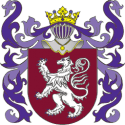CROSS. An honourable ordinary, more used as a charge in a coat of arms than any of the others. During the Crusades for the recovery of the Holy Land, the troops of the different nations that joined in the Crusade displayed crosses on their banners and arms: every soldier bore a cross upon his dress; this was composed of two pieces of list or riband of equal length, crossing each other at right angles. The soldiers of France attached their national emblem, the fleur-de-lis, to the ends of the members of the cross; hence the introduction of the cross flory. The Crusaders from the Papal dominions placed transverse pieces on each member of the plain cross, and by this means transformed it into four small crosses springing from a centre, forming what is now called the cross-crosslet. It would be impossible within the limits of this work to give an example of all the crosses that have been introduced as bearings in coats of arms. Berry, in his comprehensive work on Heraldry, gives nearly two hundred examples, without giving all that might be found. The following are the crosses most used in English Heraldry.
· Cross
· Cross potent
· Cross flory
·  Cross crosslet
Cross crosslet
· Cross bottonny
· Cross pattee
· Cross raguly
· Cross patonce
· Cross moline
· Cross quadrate
· Cross quarter-pierced
· Cross of Calvary
· Cross fitchy
· Cross patriarchal
· Cross potent rebated
